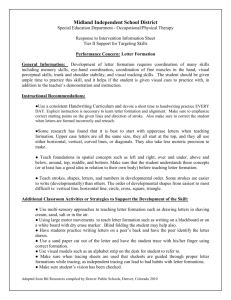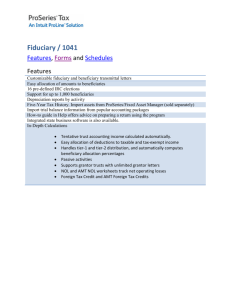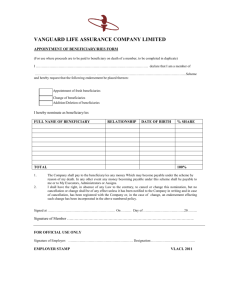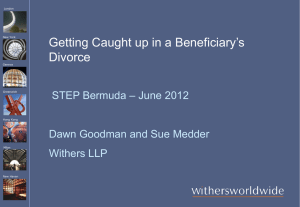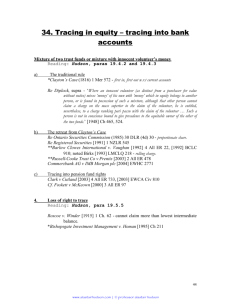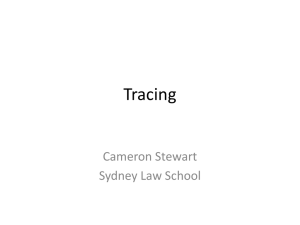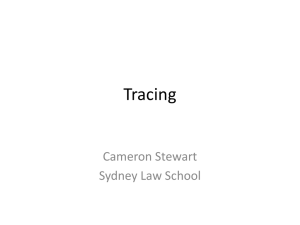Remedies for Breach of Trust PowerPoint
advertisement
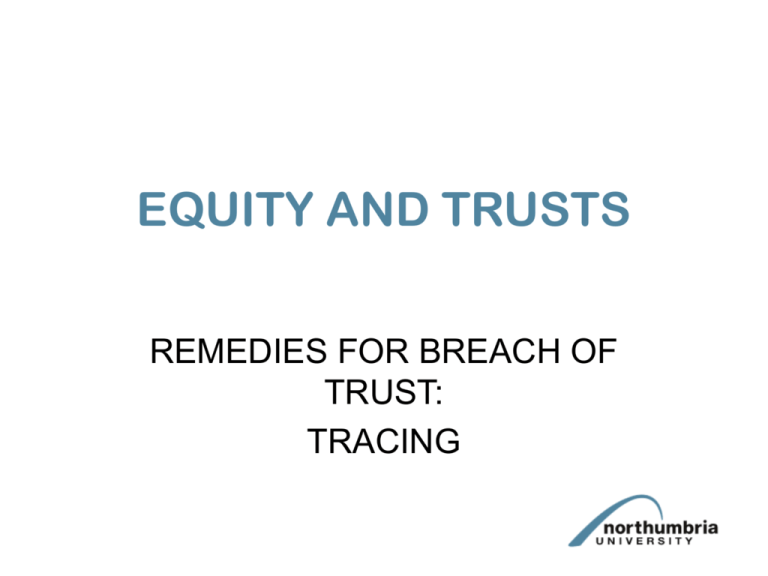
EQUITY AND TRUSTS REMEDIES FOR BREACH OF TRUST: TRACING REMEDIES Of two kinds: • Personal or • Proprietary Personal Remedies Enforceable against the person – it is an award of money Proprietary remedy Awarded against a specific asset Liability Liability for breach of trust is compensatory – g aimed at recompensing a beneficiary for their loss. Remedy is personal – trustee is compensating beneficiary for loss from the t’s own funds. Tracing Misappropriation or misdirection of trusts assets then beneficiary may choose to sue for breach or make a proprietary claim to the asset. To identify asset – “tracing” may be used. Profits Unauthorised profits: fiduciary may need to make “account” of profit and pay it over OR CT may be imposed. Can be useful where: fiduciary is insolvent or if profit is property that increases in value Tracing process can be used to identify property as trust property Remedies against third parties Personal remedy available against third party where they have assisted in breach of trust or knowingly received trust property Third Parties Third parties in these circumstances are accountable as constructive trustees – secondary liability i.e. third parties liable for breach of trustees – liability for accessory breach of trust Third parties Liability against third party is personal only Liability for dishonest assistance does not depend on receipt of trust property – so dishonest assistant is not a trustee. See Millet LJ in Dubai Aluminium v Salaam [2003] 1All ER should now discard words “accountable as constructive trustee” and substitute “accountable in equity.” Dishonest assistance • Assistance requires participation • Dishonesty of third party is required but not also on pat of trustee who is liable regardless of state of mind Dishonesty Royal Brunei Airlines v Tan [1995] 3 All ER 97 Lord Nicholls: acting dishonestly meant simply not acting as honest person in circumstances (objective standard) But see also Twinsectra v Yardley [2002] 2 All ER 377: three possible standards for dishonesty. Standards of dishonesty 1. Subjective standard – only dishonest if breaches own standards of honesty 2. Objective: if breaches ordinary standards of reasonable and honest people Third standard Combines objective/subjective: Objective test applies but person must also realise they are dishonest by those standards HL: this test should be adopted as standard Knowing receipt Leads to liability to account to trust for value of property received Reclaiming trust property Any person receives trust property takes it subject to trust – thus beneficiaries can reclaim property What if not trust property? If recipient has not trust property or traceable proceeds then only personal remedies available – But if trustee is insolvent then use – then only possibility is to impose personal liability on third party to account for knowing receipt Two related issues Personal liability to account only arises if it can be shown he received it with knowledge of trust – if so then is constructive trusteeship Knowledge • Liability as constructive trustee only imposed if requisite degree of knowledge. • But – degree needed is far from certain States of knowledge See Baden and others v Sociéte Générale pour Favoriser le Développement du Commerce et de l’lndustrie en France [1992] 4 All ER 161 Gibson J: 5 states of knowledge (i) actual knowledge; (ii) wilfully shutting one’s eyes to the obvious; (iii) wilfully and recklessly failing to make such inquiries as an honest and reasonable man would make; (iv) knowledge of circumstances which would indicate the facts to an honest and reasonable man; (v) knowledge of circumstances which would put an honest and reasonable man on inquiry. Knowledge 1-3 constitute actual knowledge 4-5 only constructive knowledge But: does person who receives with knowledge of types 1-5 be liable to account as CT or is higher degree of knowledge needed? Knowledge Some cases have founded liability on any of 1-5. Thus negligence would give rise to personal liability But 4-5 now held insufficient Re Montagu [1992] 4 All ER 308 – Megarry: recipient only liable if want of probity actual and types 1-3 indicated a want of probity but whether 4-5 would was dubious knowledge Subsequent cases have followed this approach so seems clear that recipient only liable as CT if he had knowledge of types 1-3. knowledge Recent decision in BCCI v Akindele [2001] Ch 437 introduced new test for recipient liability Norse LJ rejected Baden categories. If single test for knowing assistance then same for knowing receipt: unconscionable to retain receipt. But not clear to what degree. Recap • • • • • Trustee primarily liable for breaches Liability is compensatory Award is personal against trustee Remedy is compensatory damages Can also be account of profits Other remedies? What if trustee is insolvent when a personal remedy would be of little use? If third party involved in breach then beneficiaries can pursue the stranger Remedy is personal against third party – but secondary When property still held beneficiaries can assert proprietary claim to the property. If not and no proceeds then personal liability. Personal remedy v proprietary claims Personal remedy is only of use if defendant has means to pay Beneficiaries may purse proprietary remedies – used to identify trust property or its proceeds (exchange assets) if it is sold. Proprietary claims Is trust property misdirected or misappropriated or a profit made then proprietary claim available. How do beneficiaries decide what to do? Proprietary action Advantages: if defendant is bankrupt then beneficiaries are just creditors. But if trust property still held then proprietary claim will allow priority over creditors. Advantages Advantages: beneficiary can regain the trust property from third parties except the bona fide purchaser for value. Also – prop. Claim allows benefit of any increase in value. But beneficiary can only make claim if can identify the trust property. This depends on tracing. Tracing Is the process or method used to identify trust assets so that a remedy can be asserted – e.g. an equitable charge or personal remedy. At common law – the original owner may claim legal asset or seek remedy like damages for conversion or for money had and received. Tracing For statement on nature of tracing see Millett LJ in Foskett v McKeown [2000] 3 All ER 97 Following and tracing Millett LJ also explains difference between following and tracing. Tracing Can be done at common law or in equity But there is a major distinction between these Tracing Common law rules allow for identification of property or substitute property common law is limited: no tracing through mixed fund Tracing at common law Subject to criticism. Fiduciary concept has been placed under strain as a result. Tracing in equity Equitable tracing not defeated by mixing, conversion substitution Rules apply especially for mixed funds – evidential presumptions To use equitable tracing certain requirements must be fulfilled … Re Diplock See Re Diplock [1948] Ch 465 Claimant may trace provided there was a fiduciary relationship between the claimant and the recipient of his money that gave rise to an equitable proprietary relationship in the claimant. So must be possible to find a fiduciary relationship between the person claiming it and person who initially held funds Requirements Fiduciary relationship: criticised as too restrictive of right to trace – still applies but see Foskett Shalson v Russo Shalson v Russo [2002] Rymer J considered that Foskett did not show there is no need to demonstrate a fiduciary relationship Need for fiduciary relationship Need for fiduciary relationship for equitable tracing stands Can present difficulties in some situations Other limitations on equitable tracing Right to trace is only available to persons with equitable interest in the property Right to trace in equity is available to beneficiaries under an express trust or where circumstances are such that CT or RT arises Equitable interest This requirement is also difficult. Does a trust relationship exist under void or voidable contract or when made by mistake or when thief has possession of property ? Tracing – what can be claimed? Depends on nature of fund – mixed / unmixed or – if bank account if that is mixed No mixing of trust property If clean substitutions then beneficiary can claim sale proceeds provided they are identifiable If proceeds used to purchase an asset – can take property or have charge Mixed funds Equity uses rules to identify trust property: Affected by whose money is mixed and how it is mixed Mixed funds Where mixed fund is between trustee and beneficiary the beneficiary has first charge over it or any property purchased with it. Mixed funds Re Tilley [1967] 2 All ER 303 Ungoed-Thomas J: beneficiary has right to claim proportion of mixed fund – where asset bought wholly with trustee/beneficiary money, beneficiary can treat as trust property or as security for trust money – right applies also where part trust money and trustee money. See Foskett for restatement of rule. Mixed funds Where mix is funds of two trusts or trust and innocent volunteer then trusts share funds rateably If trustees own funds mixed as well then rule is that beneficiaries claims are met first Bank accounts If mix is in a bank account the special rules apply Bank accounts Trustee assumed to spend own money first see Re Hallet (1880) 13 Ch D 696 n.b. rule that beneficiary has first charge o property purchased from trust fund still applies SO – beneficiary has choice – claim balance or charge on property also now proportionate share of asset Bank accounts – lowest intermediate balance rule Claims are limited to balance at time of paying in – not later additions unless contributions to trust money Overdrawn accounts Cannot trace into overdrawn accounts. Backwards tracing? E.g. Loan paid off with trust money can beneficiaries trace asset bought before trust money paid off loan ? See Bishopsgate Investment Management Ltd v Homan and others [1994] 3 WLR 1270. 30. and Shalson v Russo – in which it was said backwards tracing is possible Mixing of two trusts or innocent volunteer Clayton’s Case (1816) 8 LJ Ch 256 “First in first out” rule Only applies where current running account but rule can be disapplied Barlow Clowes v Vaughan [1992] 4 All ER 22 Company collapse – under Clayton’s Case late investors would recover earlier investors not. CA held: first in first out not to be applied where impractical or unjust or contrary to express implied intention of investors Money therefore shared rateably between all investors Re Hallett Where trust money used then asset can be claimed or charge for amount owed. Where Increase in value then claiming asset would be sensible Where mixed fund then beneficiary cannot elect to take the property but can have a charge for amount owed. But – this means trustee benefits? Re Tilley can claim share according to amount of trust money used. Example Example: A mixed fund of £5000 trust fund and £5000 trustee money. Shares bought for £10,000. The beneficiary has an election – can claim proportionate share or enforce a charge. If shares increase in value then better to claim proportionate share, if they decrease then a charge would be preferable. Foskett v McKeown [2000] 3 All ER 97 Foskett – beneficiaries’ claim limited to charge Foskett v McKeown [2000] 3 All ER 97 HL: where trustee uses trust money as part of purchase price of an asset beneficiary can claim proportionate share or to have alien on it to secure personal claim. Availability of charge Charge is only available where fund consists of trust and trustee property and not where fund is made up of innocents who must be treated and share equally Innocent volunteer Trust property can be recovered from innocent volunteers but if trust money is mixed with him – then share is equal with beneficiaries When is tracing not available? Cannot trace against bona fide purchaser for value without notice of beneficiaries interest But possible to trace proceeds of sale When is tracing not available? If property is not identifiable: i.e. if dissipated or used to pay debt Personal action is alternative Subrogation Claimant in same position as secured lender – same rights as against the borrower as secured lender See Boscawen and others v Bajwa [1995] 4 All ER 769 When is tracing not available? If equitable remedy available would result in injustice then cannot be applied e.g. Re Diplock see above for defence of change of position
